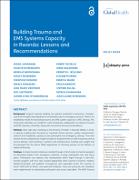| dc.contributor.author | Jayaraman, Sudha | |
| dc.contributor.author | Ntirenganya, Faustin | |
| dc.contributor.author | Nkeshimana, Menelas | |
| dc.contributor.author | Rosenberg, Ashley | |
| dc.contributor.author | Dushime, Theophile | |
| dc.contributor.author | Kabagema, Ignace | |
| dc.contributor.author | Uwitonze, Jean Marie | |
| dc.contributor.author | Uwitonize, Eric | |
| dc.contributor.author | Nyinawankusi, Jeanne d'Arc | |
| dc.contributor.author | Riviello, Robert | |
| dc.contributor.author | Bagahirwa, Irene | |
| dc.contributor.author | Williams, Kenneth L | |
| dc.contributor.author | Krebs, Elizabeth | |
| dc.contributor.author | Maine, Rebecca | |
| dc.contributor.author | Banguti, Paulin | |
| dc.contributor.author | Rulisa, Stephen | |
| dc.contributor.author | Kyamanywa, Patrick | |
| dc.contributor.author | Byiringiro, Jean Claude | |
| dc.date.accessioned | 2022-04-27T15:04:04Z | |
| dc.date.available | 2022-04-27T15:04:04Z | |
| dc.date.issued | 2021 | |
| dc.identifier.citation | Jayaraman, S., Ntirenganya, F., Nkeshimana, M., Rosenberg, A., Dushime, T., Kabagema, I., Uwitonze, J.M., Uwitonize, E., Nyinawankusi, J.D.A., Riviello, R. and Bagahirwa, I., 2021. Building trauma and EMS systems capacity in Rwanda: lessons and recommendations. Annals of global health, 87(1). | en_US |
| dc.identifier.issn | 2214-9996 | |
| dc.identifier.uri | http://hdl.handle.net/20.500.12280/2984 | |
| dc.description.abstract | Background: Surgical capacity building has gained substantial momentum. However, care at the hospital level depends on improved access to emergency services. There is no established model for facilitating trauma and EMS system capacity in LMIC settings. This manuscript describes our model for multi-disciplinary collaboration to advance trauma and EMS capacity in Rwanda, along with our lessons and recommendations.
Methods: After high-level meetings at the Ministry of Health in Rwanda (MOH), in 2016, a capacity building plan focusing on improved clinical services, quality improvement/ research and leadership capacity across prehospital and emergency settings. The main themes for the collaborative model included for empowerment of staff, improving clinical service delivery, and investing in systems and infrastructure. Funding was sought and incorporated into the Sector Wide Approaches to Planning process at the Ministry of Health of Rwanda.
Findings: A shared mental model was created through a fully funded immersion program for Rwandese leaders from emergency medicine, nursing, prehospital care, and injury policy. Prehospital care delivery was standardized within Kigali through a train-thetrainers program with four new context-appropriate short courses in trauma, medical, obstetric/neonatal, and pediatric emergencies and expanded across the country to reach >600 staff at district and provincial hospitals. Forty-two protocols and checklists were implemented to standardize prehospital care across specialties. The WHO Trauma Registry was instituted across four major referral centers in the country capturing over 5,000 injured patients. Long-term research capacity development included Masters’ Degree support for 11 staff.
Conclusions and Recommendations: This collaboration was highly productive in empowering staff and leadership, standardizing clinical service delivery in EMS, and investing in systems and infrastructure. This can be a useful model for trauma and EMS system capacity development in other LMICs. | en_US |
| dc.language.iso | en | en_US |
| dc.publisher | Ubiquity Press Ltd , Unit 3.22, East London Works, 65-75 Whitechapel Road, London, England, E1 1du | en_US |
| dc.relation.ispartofseries | Annals of global health;87(1) | |
| dc.subject | Trauma | en_US |
| dc.subject | Systems capacity | en_US |
| dc.subject | Recommendations | en_US |
| dc.subject | Rwanda | en_US |
| dc.title | Building Trauma and EMS Systems Capacity in Rwanda: Lessons and Recommendations | en_US |
| dc.type | Article | en_US |


